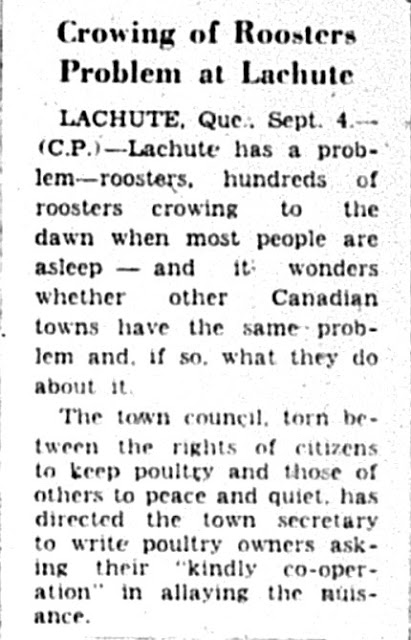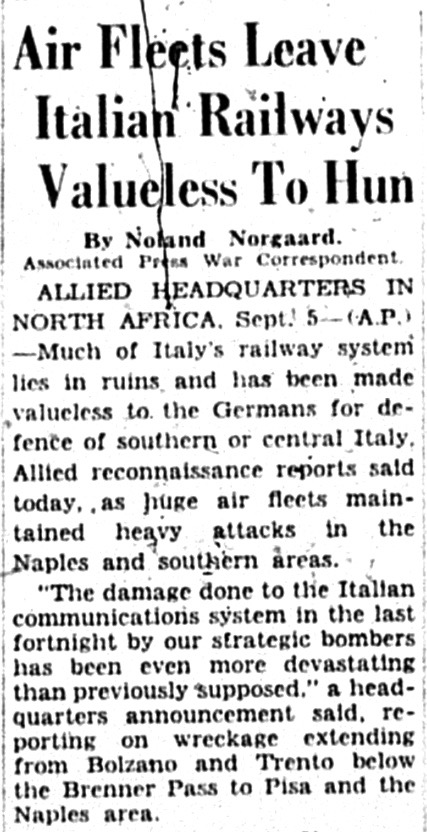The Tide is Turning. Allies Step Into Italy Easily
Caution. The first step was easy, that is, the landing at Reggio.
Moving northward toward Naples and Rome will not be easy
Moving northward toward Naples and Rome will not be easy
Introduction:
On September 4th, 1943, a reader of any major newspaper in North America would find details about various war fronts that were 1000s of miles apart.
German troops were "falling back under heavy Russian blows"; two million pounds "of bombs (were) hurled on Berlin"; Italian troops were surrendering in large numbers after "the Allied landings in Calabria"; and, if one was to dig deep enough, news from the South Pacific would be discovered as well.
Amongst all the news articles and photographs, one with an interest in what Canadians in Combined Ops were doing in 1943 would find some informative details here and there.
For example, before the day of invasion (D-Day was early morning, Sept. 3) we read that "in virtually every cove, landing craft were drawn up on the sand awaiting their cargoes of men and weapons of war." And in those landing craft would be found sailors born and raised in towns and cities across Canada.
Photo from an online site - RAF Beach Units, W.S. Sinclair
As well, two or three days after the invasion at Reggio (on the toe of Italy's boot, on the very early morning of September 3rd) we discover that "Canadian sailors, including some from Ottawa... are getting a bit bored running a shuttle service between Sicily and Italy."
Bored already? Based on my research, the young men of the RCNVR who manned landing crafts (as volunteer members of the Combined Operations organization) still had about 4 week's worth of work ahead of them before the beachheads were firmly established and properly supplied.
Fortunately, the initial landings in Italy were quite peaceful and boredom was vanquished in several ways once an 'on and off' work schedule was organized.
One paragraph from my father's notes reveals that the sailors did enjoy some freedom to travel once their work for the day was completed:
We operated our landing craft under these conditions (i.e., "from day one we had no problems; it was easy come, easy go from Sicily to Italy.") with skeleton crews and we enjoyed time off. Some of us went to Italy, hitched rides on army trucks, went as far as we were allowed to go and had a good look at some of Italy. We lived on the edge, because not far from the shoulder of the asphalt road were high cliffs and we could look down on the Adriatic Sea, its beautiful beaches and menacing rocks.
"Dad, Well Done", page 116
More details about their work and recreation will be presented as more entries are made from The Evening (Ottawa) Citizen.
And now, something completely different:
My father writes:
One day at Messina, the late LT Andy Wedd asked me if, with my rural background, I knew about poultry. I informed him that the subject was right down my alley. He then told me of the location of six or eight beautiful hens and asked if I would help him divest the owner of the same.


More details about their work and recreation will be presented as more entries are made from The Evening (Ottawa) Citizen.
The following news clips will, for the most part, provide a variety of details from the Mediterranean theatre of war, in which about 200 Canadians in Combined Ops participated for one month or more:
And now, something completely different:
I know. A story about poultry seems to have little or no place in the serious actions related to WW2. I agree. But what about a place in non-serious actions in Sicily?
One day at Messina, the late LT Andy Wedd asked me if, with my rural background, I knew about poultry. I informed him that the subject was right down my alley. He then told me of the location of six or eight beautiful hens and asked if I would help him divest the owner of the same.
When he asked how we could keep the hens quiet, I told him, “With an axe!” Or, we could firmly grasp their necks and tuck their heads under their wing and rock them for awhile. We chose the latter because it actually works. By now, of course, our mouths are watering.
We went in at dark, like another raid, and entered the outside pen with a flashlight, a kit bag and mitts on. Andy slowly cinched each one by the neck, handed them to the master who rocked them to sleep and lowered them quietly into the kit bag. His idea of a beautiful hen sure didn’t match mine! Anyway without a squawk we cleaned the roost and proceeded to the officers’ mess, kit bag between us.
In the morning, the Sicilian cook came in with one hell of a snit. Somebody had stolen his mama mia’s chickens. Andy said he was the first Sicilian he had met that was ready to fight and never let it out of the bag about our midnight raid and feast.
"Dad, Well Done", page 71
We went in at dark, like another raid, and entered the outside pen with a flashlight, a kit bag and mitts on. Andy slowly cinched each one by the neck, handed them to the master who rocked them to sleep and lowered them quietly into the kit bag. His idea of a beautiful hen sure didn’t match mine! Anyway without a squawk we cleaned the roost and proceeded to the officers’ mess, kit bag between us.
In the morning, the Sicilian cook came in with one hell of a snit. Somebody had stolen his mama mia’s chickens. Andy said he was the first Sicilian he had met that was ready to fight and never let it out of the bag about our midnight raid and feast.
“Tuck their heads under their wing and rock them for awhile...”
Doug Harrison in later years. He loved his chickens! GH
"Dad, Well Done", page 71
The Canadian flotilla of landing crafts (LCMs) was instrumental in helping Allied forces establish "a series of sub-joined bridgeheads":
War correspondent Ross Munro (mentioned above) was one of a few Canadians who witnessed the initial landings at Reggio. (Munro accompanied troops aboard our landing crafts and more about that will appear later. His stories are of no small significance to this day).
Another correspondent I grew very interested in was Sholto Watt of The Montreal Star. He contributed a large number of stories while in The Med and readers can find several by visiting Editor's Research in the A - Z Directory (see 'Click on Headings' in right hand margin).
This article appears previous entries because Mr. Watt was an eye witness to the 100s of landing crafts abuzz in the waters of the Messina Strait:
The people of Sicily - some very weary of war, I am sure - were witness to a vast barrage before the invasion of Italy took place. Also of note, this is the first time I have read the phrase "stand up invasion." It likely means that because there was little opposition and the beaches were flat (they were "dream beaches" said one Canadian navy officer), troops were able to walk - not run - off the landing crafts without being decimated by German resistance.
Though the landings were peaceful on the toe of the boot, once the Allied troops moved inland they soon encountered stiff resistance and delaying actions (mine fields). Allied troops did not reach the centre of Rome until June, 1944:

Many informative articles are found in the next issue of The Ottawa Citizen as well:
Readers are quickly reminded that the war front is very wide!
Russian forces are pushing forward and also meeting stubborn resistance in the form of German minefields and more:
Along the "Toe" the Allied landings are swift and successful. Yes, but don't get your hopes up! (The Salerno landings on Sept. 9 were a different matter entirely. Details will follow):

Please note that this lengthy article, by Edward Kennedy, Associated Press (AP), includes information from Paul Kern Lee (AP), above, and now from three other war correspondents, one from the U.S. and two Canadians you may have already heard about in this post. On a few occasions I have come across articles like this and have learned that war correspondents invested time and energy into team work, by sharing resources and reports.
Readers will undoubtedly notice the "less than stellar quality" of my reproduction of the news articles from The Citizen. Only a small amount of wartime news has been digitized (producing excellent clarity or resolution) and the quality of microfilm and microfilm readers varies from 'quite good' to 'not so good'. Though I could type the articles myself, I find it easier and faster to share the news 'as is'. (If I had to type everything, we would still be back in 1939).
Hopefully, readers can survive with 'good enough' until digitization catches up to the millions of newsreels, films, newspapers, etc., produced in the 1940s.
Edward Kennedy continues:
Speaking about team work in the media: We learn about progress made by Canadian forces working with the British 8th Army in a Canadian newspaper running a C.P. article out of the U.S. from the British Broadcasting Company by way of the C.B.S. Team work!
A significant article follows by Canadian Ross Munro:
Please note the important connections between particular Canadian forces in the last paragraph above. So much of the success of operations - even the possibility of success of operations - depended on getting feet on the ground, via landing crafts, and then supplying those feet on the ground with continuous mountains of supplies via landing crafts and a vast transportation and communication network. I have said before, there were no small roles during World War 2.
No reporter's name is given with this short piece. But someone decided, just for a moment, to shine a spotlight on one million of the Sicilians (among other millions) who were sensing and tasting freedom after year's of subjugation by Fascist Italy and Nazi Germany. I wish I'd been in the Strait of Messina with the Canadian flotilla of landing crafts during Operation Baytown:
The following article was included in the memoirs of Canadian sailor Lloyd Evans, who I was fortunate enough to meet in Markham, Ontario, before he passed away. We traded stories and written memoirs (his own for my father's book). It serves as a centrepiece for a short series I am doing on this site, now only partly finished.
Please link to "Canadian Flotilla of Landing Crafts in Italy (2)" for more details.
The Ottawa Citizen was chock full of good news for and about Canadians in Combined Operations on September 6, 1943, even though they were far from finished their work shift (which extended into October):
Another excellent article by Ross Munro, one that could surely act as a centrepiece - in the near future? - for a short series of posts re Canadians in Combined Ops!
Any time I see a name linked to London, Ontario (my place of residence) I feel I need to start looking through the phonebook to see if family members of the veteran still survive. We shall see what we shall see.
More news from The Ottawa Citizen to follow.
Unattributed Photos GH


















































No comments:
Post a Comment